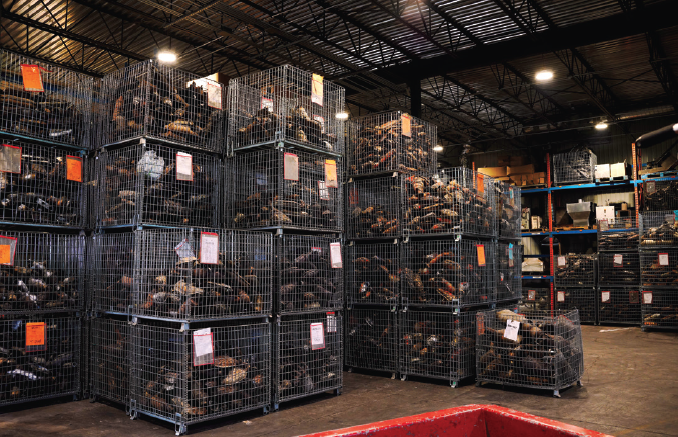1-855-901-5050
4640 Grande-Allée Boulevard
Boisbriand, Québec
J7H 1S7
pmrcc.com

By Cliff Hope, Senior Account Manager, PMR Inc.
 One of the bigger challenges in understanding returns from catalytic converters is knowing what you have before anyone else evaluates your material. Most automotive and scrap recyclers do not have an inhouse expert able to quantify the material.
One of the bigger challenges in understanding returns from catalytic converters is knowing what you have before anyone else evaluates your material. Most automotive and scrap recyclers do not have an inhouse expert able to quantify the material.
To start, we all need to agree that tick marks on a sheet of paper—while seemingly accurate—do not provide real averages or anything close to inventory control. Believing there is a consistent average of units per box is another miscalculation. When it comes to converters, there are too many variables to consider, and you cannot rely on these types of simplistic conclusions. This is not a box of copper wire or starters that have a consistent weight or size.
In my experience visiting automotive recyclers, most have dismantlers removing converters and placing them in a central bin that eventually gets moved to a secure location by a manager. It is at this point that the units are counted into a Gaylord box or holding container. Respectfully, how many yard owners/managers can honestly say they know what type of material is going into the box? After years of yard tours, my answer is very few. Here is where the problems start: one tick mark, one converter, right? Unfortunately, there are several different types of converters and some that are two units that look like one.
a) Is the converter an OEM gasoline/diesel/foil?
b) Is it an aftermarket?
c) Is the unit an OEM ceramic/foil combo (meaning it’s two units)?
d) Is this a branch with multiple converters?
e) What are the percentages of each type of material?
f) Are your material percentages different from the yard history?
For those of us in the converter business it is easy to tell the difference between the material types. Many on the front lines don’t want their employees to know the difference or make any judgement calls when it comes to counting and securing the material. So, how can a yard reasonably and securely take stock? More importantly, why is converter inventory knowledge so important?
In today’s market the converter is factored in when purchasing the car for its parts or recycling value. From my interactions with recyclers, they tend to build in pricing from core buyers or what they think/have been told the can average is. Problem being, if the reporting from the vendor is a feel-good high average number, then the pricing going into the car purchase can be exaggerated or undervalued. In either case, it can mean a financial loss or a missed opportunity to purchase the vehicle.
If a yard is to have any chance of understanding what they have, the choice of vendor is critically important. Is your vendor willing or able to act more as a consultant, assisting you with material identification/separation prior to handling you cats? If the answer is no, then you need to ask yourself how transparent is my vendor?
1. Identify and separate OEM converters from aftermarkets
2. Identify and separate ceramic converters from foil units
3. Identify and separate diesel converters
4. Identify the fullness of all units
5. Identify combination and branch units
With proper material separation and counts, you have a place to start. As you are tracking month-to-month, you can start observing patterns in your material type averages. Working with a toll refiner will give you even more information as it offers weights of material and precious metal loadings that can be applied to current metal markets. Only with historic averages and proper counts can a yard know where it is with a projected inventory value. If you have always wondered what happened with cats this month but don’t have proper inventory control and history, it is easy to place the blame on your buyer.
I can almost hear the reactions from busy yard owners reading how material should be inventoried and tracked, “We just don’t have the time or resources to manage this type of in-depth tracking!” Admittedly, it seems like a large task. That is why PMR has designed a simple and easy platform that assists with all the steps. If your employees can operate a smartphone, you too can track all the information required to take control of inventory.
PMR has a complete converter solution; we call it our Supplier Services Platform (SSP), that offers a way to visually track every converter that comes into inventory and have a value assigned for managers and owners to view—with the ability to keep material values hidden from frontline workers. We also provide extensive catalogs on the values of converters by serial number and can give instant evaluations with our photo grading tool.
If you are tired of never being sure of what happened with converters this month, we have the solution for you. Call us today and our committed team will be able to get you started on your way to a knowledge-based approach to take control of your converter inventory and start making better purchasing and selling decisions.
© Media Matters Inc ~ All Rights Reserved